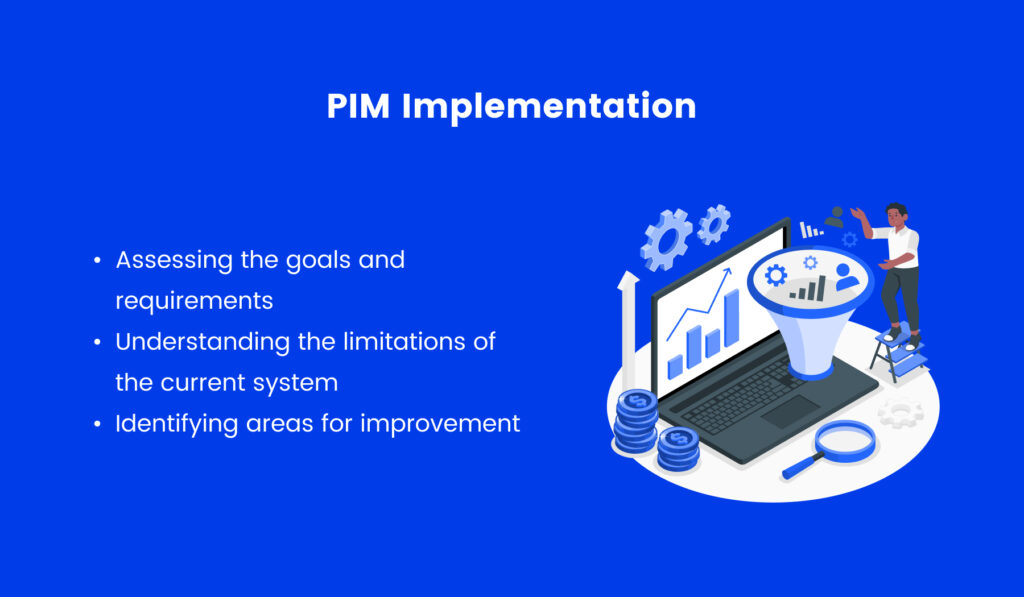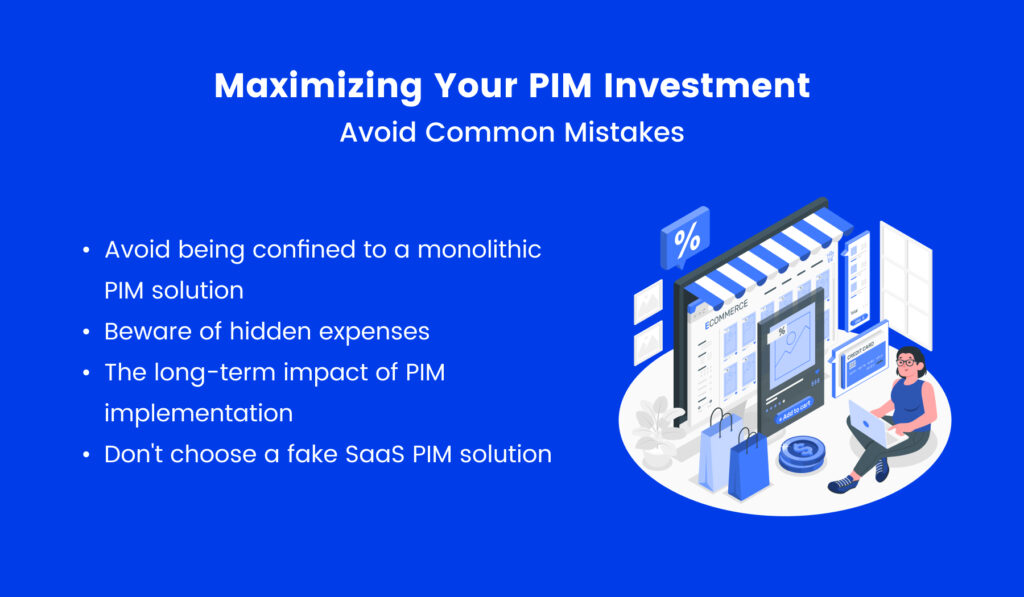What is PIM solution?
A Product Information Management (PIM) system is an essential business software that enables organizations to efficiently collect, manage, and optimize their product data in one centralized location.
The primary objective of a PIM solution is to enhance the performance of product selling across multiple touchpoints. By implementing a PIM system, businesses can deliver a seamless and engaging product experience to their target audience. Moreover, it results in increased product sales and customer satisfaction.
For further details about the PIM system, head to our page “PIM software”
Transform your ecommerce business with the power of unified product data management
With Apimio PIM, experience the ease of managing all your product data from a single, centralized source.
Common challenges in PIM Implementation
According to the latest statistics for 2021, PIM adoption is expected to increase significantly, with around 50% of companies planning to incorporate PIM into their business operations. Additionally, companies with clear ecommerce strategies and plans achieved 27.1% better results than those without. This highlights the importance of having a well-defined plan when implementing PIM.
There are several reasons why businesses choose to implement PIM solutions. Some common challenges they face without a PIM system include
- Slow data syncing and loading
- Limited scalability to support new business objectives
- Poor user experience caused by an unintuitive user interface
- Incompatibility with third-party applications
- Expensive subscription plans that include unnecessary features.
To address these challenges, businesses require a high-quality PIM platform that is customizable for different locations and multiple languages, and can handle increasing numbers of SKUs. By doing so, teams gain a single source of truth when working with product information, which simplifies data flow with third-party systems through features like a vendor portal.
How to choose the right PIM solution?
Selecting the optimal PIM system for your organization is a critical decision that requires careful consideration of multiple factors. With so many different solution providers, configuration options, and complicated terminology, it’s essential to make a careful decision.
As your ecommerce business evolves, your data management needs will likely change. Selecting a PIM system that can accommodate these changes and adapt to your organization’s evolving requirements is crucial.
1. Create a team of stakeholders
Having a strong team of stakeholders can make all the difference in ensuring a successful implementation. The first step is to identify the key stakeholders for the PIM implementation.
For efficient implement a PIM system, e-commerce leaders must bring together relevant personnel from different departments, including marketing, sales, IT, product development, technical documentation, and inventory management. These teams typically rely on manually gathered and updated product data in the absence of a PIM system. They are aware of the challenges faced by the existing systems and workflows. Thus they can offer valuable insights about the necessary features and integration capabilities required by the organization’s PIM system.
2. Set clear goals for system implementation
After identifying the key stakeholders, now is the time to decide and define the project scope. The project scope will include the overall plan of the methodology to evaluate the PIM system.

Assessing the company’s goals and requirements
To ensure seamless implementation of PIM for ecommerce solutions, it is important to focus on both fundamental and intricate elements. This involves identifying the essential role of the PIM solution in driving greater revenue and success to the overall business.
- Define your business objectives and how PIM fits into your overall strategy.
- Identify the specific pain points or challenges that you are trying to solve with PIM.
- Determine what data you need to manage and how it will be structured and organized.
- Establish a timeline and budget for implementation, considering any potential roadblocks or delays.
Understanding the limitations and challenges of the current system
The limitations of the PIM solution can help you identify the specific requirements your business needs to achieve its goals and avoid common mistakes in implementation. Here are some key points to consider:
- The most significant challenges of the current system is the fragmentation of product data across various systems, applications, and departments.
- Inefficient workflows, such as manual data entry, can cause errors and delays in updating product information. It can also result in inconsistencies in the product data.
- Without a robust data governance framework, data quality can become a significant issue.
Identifying areas for improvement
The key areas of improvement include the following:
- Develop a clear communication plan to keep all stakeholders informed and aligned throughout the implementation process.
- Set measurable goals and key performance indicators (KPIs) to track the success of your PIM implementation.
- Continuously evaluate and optimize your PIM strategy to ensure it continues supporting your business objectives over time.
3. Identify necessary features
Before you schedule a demo, it is necessary to check out all the details of the Pim solution. Afterward, stakeholders clearly define the product requirements of their PIM system and document them accordingly. This includes identifying the necessary integration of the PIM system with other software such as inventory control, procurement, web sales or POSWhat is a Point of sale? As the name states, POS is the point at which sales can be made physically. Example of Point of SaleAn... More systems.
The stakeholders responsible for this task should compile a comprehensive product requirements document outlining the features and capabilities required for the PIM system and desirable features. Additionally, the team should evaluate each potential PIM system based on these requirements and other criteria, such as budget constraints.
4. Evaluate the PIM system
Evaluating a PIM system requires a holistic approach. It’s not just about the features and functionality. Also, more importantly, you need to consider the long-term impact of PIM solution on your business.
When e-commerce leaders are considering different systems to implement, they may end up with a long list of options that are difficult to evaluate. To simplify the process, they can narrow down the list by focusing on the product requirements and eliminating any systems that are too expensive or lack essential features.
Although PIM systems cannot solve all e-commerce challenges, PIM for ecommerce provides a solution for centralizing product data management across the organization. This centralized approach ensures that employees from various departments have access to reliable product information. As a result, customers also benefit from consistent and accurate product information across all sales and marketing channels.
5. Try the unlimited power of the cloud
A high quality PIM system should be capable of accommodating an increasing number of SKUs and handling increased traffic during peak sales periods. Therefore, scalability is a crucial factor, and cloud-based solutions can ensure it to prevent your e-commerce website from crashing in the middle of a high-demand event like Black Friday.
The market shifts towards cloud-native, multi-tenant SaaS PIM solutions in this rapidly growing e-commerce landscape. These solutions offer automated updates and limitless scalability. Hence, making them increasingly popular among companies seeking efficient and reliable PIM software.
Apimio’s cloud PIM solution is an efficient and cost–effective solution for easy maintenance and access to information. The product scoring option is one of the distinct characteristics of this PIM. This helps e-commerce business owners to leverage its benefits and stay ahead of their competitors.
6. Start early with data migration
If you have not prepared data for migration, now is the time to prepare data for the migration process. Firstly, identify the primary origins of master data in the initial stages and start preparing it for a smooth import process.
Determine the duration and resource types needed to achieve the desired benefits from the PIM system within the expected timeframe. By doing so, you will be able to achieve the end goal of PIM for ecommerce implementation.
7. Connect multiple systems and channels
If you have a previous bad experience with PIM that involved slow syncing, explore the API economy, a business model that revolves around utilizing APIs (application programming interfaces) in the digital realm. With REST API endpoints, PIM can integrate with other platforms and systems, such as Shopify, Amazon, or Magento.
With Cloud becoming the essential data source, Apimio PIM integrates well with Shopify to provide accurate, consistent data. You can add and update products to Shopify with a single click.
It’s important to note that the API-centric PIM software vendor should provide wide range of management APIs. It’s also worthwhile to inquire whether the PIM supports open APIs publicly accessible to software developers, as they provide high-speed access to product content for immediate use.
Maximizing Your PIM Investment: Avoid These Common Mistakes

1. Avoid being confined to a monolithic PIM solution
Are you tired of being stuck with a monolithic PIM solution? It’s time to break free and explore other options!
A monolithic application manages all functions from a single code base, making development, testing, and deployment more straightforward. Despite this advantage, making even minor adjustments requires deploying the entire application. Additionally, scaling a large, singular block over time can pose significant challenges.
An API-first PIM system allows seamless integration with other platforms and systems, providing flexibility and customization. Don’t limit yourself to a rigid, all-in-one solution that may not meet your business needs. With an API-first approach, you can tailor the PIM system to fit your requirements and adapt to any changes in the future.
Are you looking for an API-first PIM system to fit your unique requirements?
Say goodbye to monolithic PIM solution and embrace the freedom of an API-first Apimio PIM solution!
2. Beware of hidden expenses
When implementing PIM for ecommerce, do not let hidden costs increase your organizational expenses to a greater extent. While the initial cost may seem manageable, additional expenses can add up quickly.
So, book a demo and have an open conversation with the PIM vendor to clarify any potential hidden fees of the PIM system. However, there should be no extra charges for updates and acquiring access to new features in software, mainly when dealing with SaaS solutions. Choose a PIM system that fits your budget, with transparent pricing and a comprehensive list of expenses that can help you avoid unexpected charges.
3. Thinking ahead: the importance of considering the long-term impact of PIM Selection
It’s important to consider the long-term impact of the software when selecting a PIM solution. Choosing the inappropriate solution can result in costly and time-consuming changes.
Consider the scalability of the PIM system and whether it can adapt to your business’s growth and evolving needs. Evaluate the vendor’s track record, including their experience in implementing and supporting PIM solutions.
Additionally, think about the impact on your organization’s workflow, including how the PIM system will integrate with existing systems and whether it will require significant changes to business processes.
4. Don’t choose a fake SaaS PIM solution
PIM providers who claim their solution as software as s service is not always true. Some Pim for ecommerce solution providers put their on-premises PIM into a hosting server and call it SaaS. A few integral questions you should ask your software providers are as follows:
- Is your software cloud–native?
- Is your PIM system a multi-tenant SaaS?
- How long the PIM solution takes to integrate with other platforms?
- How often is the PIM system upgraded?
The answers to all these questions should be positive to select an appropriate PIM for ecommerce.
PIM: The Key to Effective Enterprise Data Management
In 2020, the global PIM market was valued at $9.90 billion in 2019, and is projected to reach $59.25 billion by 2027. And to put it into further perspective, it’s growing at a CAGR of 25.2% from 2020 to 2027. That’s very huge!
To properly evaluate your PIM needs, it’s important to assess your current business processes and measure them against the different stages of the information supply chain: data onboarding, data management, and data distribution.
Consider the following key points for each stage to ensure a comprehensive evaluation.
Data Onboarding
Businesses of all sizes are familiar with the typical data challenges, such as managing supplier information, product details, and maintaining numerous spreadsheets. Among these challenges, data onboarding is one of the most significant.
Data onboarding is a critical stage in any PIM solution. To ensure a streamlined implementation process, consider the sources of your product data and whether they are compatible with the PIM system. Moreover, evaluate the ease of data integration and whether the PIM solution supports automated data ingestion. Lastly, assess the level of data enrichment required and whether the PIM system can accommodate it.
Data Management
After businesses have successfully set up product information from multiple sources, the next challenge is data management. To provide accurate information for internal teams and seamless customer experience, it is imperative that businesses maintain consistent product information.
Consider the level of control you require over your product data, including the ability to manage and manipulate data fields. Then, evaluate the PIM solution’s ability to automate data workflows and reduce manual intervention. Moreover, consider the PIM solution’s ability to provide actionable insights and reporting to enable data-driven decision-making.
Data Distribution
The final stage of the information lifecycle is data distribution, which involves connecting with internal departments and external channels.
When a PIM solution has the capability to communicate directly with information endpoints, it streamlines the process, eliminating the need to manually send files to each channel. This automation can significantly simplify the data distribution process, allowing for more efficient communication with external channels and greater control over internal data sharing.
Future proof your e-commerce business with Apimio
By embracing the latest advancements in e-commerce, mature companies have maximum freedom in building their tech stacks and react rapidly to the changing market demands.
Apimio PIM solution enables long-term agility, unlimited scalability, high sync speed, and other customization capabilities. With this composable approach, Apimio PIM is one of the lego blocks you need to sync data and market it to advanced marketplaces in one go.
Get started with Apimio PIM
Pim is the first and foremost step in making products appealing in the competitive online retail market. With the centralized hub for product content and digital assets, you can manage, optimize, and publish all the content from a single source.
Your organization’s data is one of its most valuable assets, and it’s essential to ensure that the PIM solution you choose provides robust data protection measures to keep your information secure. Book a free demo with our professionals to learn more about PIM and how it can help businesses sell better and faster.
What to do next?
- Choose the best PIM solution, Apimio to manage your product data and grow sales. Sign Up here.
- Read more about our Product Information related Guides here.
- Contact our support or comment your thoughts under the blog section if you have any further questions.
Frequently asked questions
In ecommerce, PIM refers to software solutions that help businesses centralize and manage product information. PIM systems allow e-commerce companies to streamline their product data and keep it consistent across various channels. Also, it enables them to manage their product catalogs more efficiently and increase overall operational efficiency
Apimio’s advanced data management capabilities, such as data cleansing and enrichment, help businesses maintain accurate and consistent product information.
Apimio PIM solution stands out in the market due to its unique content product scoring feature. The content product scoring evaluates the quality and completeness of product information, helping businesses identify gaps and make improvements.
The key components of a PIM system typically include:
· Data Modeling
· Data Enrichment
· Data Governance
· Integration
· Publishing and Distribution
Overall, all these components of a PIM system work together to streamline the management of product information, improve data accuracy and consistency, and enhance the customer experience.



